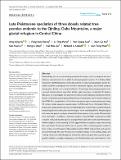Files in this item
Late Pleistocene speciation of three closely related tree peonies endemic to the Qinling–Daba Mountains, a major glacial refugium in Central China
Item metadata
| dc.contributor.author | Xu, Xing-Xing | |
| dc.contributor.author | Cheng, Fang-Yun | |
| dc.contributor.author | Peng, Li-Ping | |
| dc.contributor.author | Sun, Yan-Qiang | |
| dc.contributor.author | Hu, Xian-Ge | |
| dc.contributor.author | Li, San-Yuan | |
| dc.contributor.author | Xian, Hong-Li | |
| dc.contributor.author | Jia, Kai-Hua | |
| dc.contributor.author | Abbott, Richard J. | |
| dc.contributor.author | Mao, Jian-Feng | |
| dc.date.accessioned | 2019-06-24T16:30:08Z | |
| dc.date.available | 2019-06-24T16:30:08Z | |
| dc.date.issued | 2019-06-17 | |
| dc.identifier | 259379602 | |
| dc.identifier | 5a976e4f-2a93-4945-af28-ce7f21a89e89 | |
| dc.identifier | 000476593800011 | |
| dc.identifier | 85069523856 | |
| dc.identifier.citation | Xu , X-X , Cheng , F-Y , Peng , L-P , Sun , Y-Q , Hu , X-G , Li , S-Y , Xian , H-L , Jia , K-H , Abbott , R J & Mao , J-F 2019 , ' Late Pleistocene speciation of three closely related tree peonies endemic to the Qinling–Daba Mountains, a major glacial refugium in Central China ' , Ecology and Evolution , vol. Early View . https://doi.org/10.1002/ece3.5284 | en |
| dc.identifier.issn | 2045-7758 | |
| dc.identifier.other | RIS: urn:D883DCEE76CD320409DEB1E9033B2A8F | |
| dc.identifier.uri | https://hdl.handle.net/10023/17954 | |
| dc.description | This research was supported by the Natural Science Foundation of China (No. 31471898) and the Key Technology Research of Oil Peony Industry in Shaanxi Province (2014HXFWYL016) and Special project to Build World‐class Disciplines Of Beijing Forestry University (2019XKJS0324). | en |
| dc.description.abstract | Determining the factors promoting speciation is a major task in ecological and evolutionary research and can be aided by phylogeographic analysis. The Qinling–Daba Mountains (QDM) located in central China form an important geographic barrier between southern subtropical and northern temperate regions, and exhibit complex topography, climatic, and ecological diversity. Surprisingly, few phylogeographic analyses and studies of plant speciation in this region have been conducted. To address this issue, we investigated the genetic divergence and evolutionary histories of three closely related tree peony species (Paeonia qiui, P. jishanensis, and P. rockii) endemic to the QDM. Forty populations of the three tree peony species were genotyped using 22 nuclear simple sequence repeat markers (nSSRs) and three chloroplast DNA sequences to assess genetic structure and phylogenetic relationships, supplemented by morphological characterization and ecological niche modeling (ENM). Morphological and molecular genetic analyses showed the three species to be clearly differentiated from each other. In addition, coalescent analyses using DIYABC conducted on nSSR variation indicated that the species diverged from each other in the late Pleistocene, while ecological niche modeling (ENM) suggested they occupied a larger area during the Last Glacial Maximum (LGM) than at present. The combined genetic evidence from nuclear and chloroplast DNA and the results of ENM indicate that each species persisted through the late Pleistocene in multiple refugia in the Qinling, Daba, and Taihang Mountains with divergence favored by restricted gene flow caused by geographic isolation, ecological divergence, and limited pollen and seed dispersal. Our study contributes to a growing understanding of the origin and population structure of tree peonies and provides insights into the high level of plant endemism present in the Qinling–Daba Mountains of Central China. | |
| dc.format.extent | 21 | |
| dc.format.extent | 2540067 | |
| dc.language.iso | eng | |
| dc.relation.ispartof | Ecology and Evolution | en |
| dc.subject | Ecological niche modeling | en |
| dc.subject | Genetic divergence | en |
| dc.subject | Multiple refugia | en |
| dc.subject | Niche divergence | en |
| dc.subject | Phylogeography | en |
| dc.subject | Speciation | en |
| dc.subject | Tree peony | en |
| dc.subject | QH301 Biology | en |
| dc.subject | QH426 Genetics | en |
| dc.subject | DAS | en |
| dc.subject.lcc | QH301 | en |
| dc.subject.lcc | QH426 | en |
| dc.title | Late Pleistocene speciation of three closely related tree peonies endemic to the Qinling–Daba Mountains, a major glacial refugium in Central China | en |
| dc.type | Journal article | en |
| dc.contributor.institution | University of St Andrews. School of Biology | en |
| dc.identifier.doi | 10.1002/ece3.5284 | |
| dc.description.status | Peer reviewed | en |
This item appears in the following Collection(s)
Items in the St Andrews Research Repository are protected by copyright, with all rights reserved, unless otherwise indicated.

